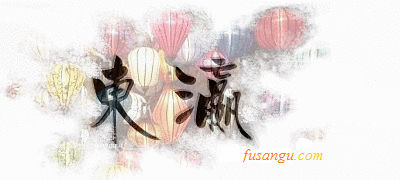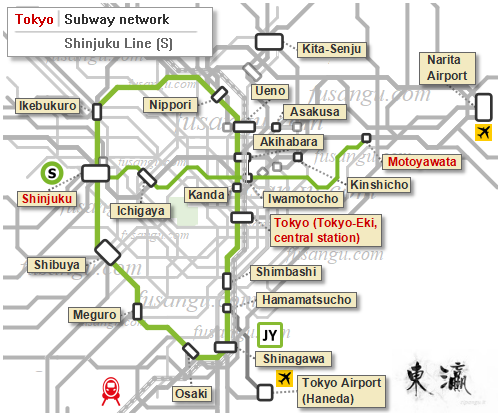
The Shinjuku-sen is one of the four subway lines managed by Toei, a municipal transportation company.
The line runs north of the city centre, connecting some of the city’s most popular tourist areas such as Shinjuku, Bunkyo, Ueno. The line continues into the eastern suburbs where it connects to the lines that serve the connection with Chiba and Narita Airport.
In this page we describe a one-day tour along the Shinjuku Line. The article includes a programme suitable for short stays.
Main sightseeing places along the Shinjuku Line
The Shinjuku Line runs along a west-east direction north of the centre of Tokyo. The line connects the following areas:
-
Shinjuku, the core of the modern city, a large district known as an entertainment hub. Shinjuku offers also a few sightseeing places of notable cultural importance;
-
Chiyoda, central district. A major station served by Shinjuku Line, the Kudanshita Station, is very close to Yasukuni Shrine;
-
Bunkyo, a central district where you can find important traditional gardens, temples and shrines;
-
Ueno, a neighbourhood of Taito district, most noted for the presence of important museums and a large park; here are some interesting temples and shrines;
-
Chuo, central district. The Shinjuku Line serves the area of Bakurocho, where you can find lots of hostels and cheap mid-range hotels;
-
Morishita: a neighbourhood famous for the numerous sumobeya, traditional sumo schools;
-
Ichikawa, where is the terminus, Motoyawata Station, a small town where are a few ancient temples and shrines such as Hokekyo-Ji and Katsushika Hachiman Shrine.
Recommended itinerary along the Shinjuku Line
We suggest you begin your tour starting from Iwamotocho Station, near Akihabara:
-
9:00 - 11:00: visit to Akihabara, the otaku The core of the district lies next to Akihabara Station. You can reach it on foot from Iwamotocho Station. The area is rich in shops that cater to anime, manga, video games and modellism buffs. Below the viaduct of the Yamanote Line (linking Ueno and Akihabara) are a few boutiques and craftsmen’s shops;
-
11:00 - 11:30: lunch near Akihabara;
-
11:45 - 12:45: visit to Jimbocho. The area is famous for the copious presence of elegant cafes and large bookshops;
-
13:00 - 14:30: visit toYasukuni Shrine. The famous shrine is a few steps away from Kudanshita Station. After visiting Yushukan Museum you can take a walk along the northern moat of the Imperial Palace. Not to be missed in spring is Chidorigafuchi;
-
15:00 - 19:00: visit to Shinjuku. Aside from the large commercial area next to Shinjuku Station, a real maze, you can begin your visit with a few museums. One of them is Shinjuku Historical Museum, close to Akebonobashi Station and the Toy Museum. We suggest you also include a visit to Shinjuku-Gyoen, a large park. You can then spend the evening and night in Shinjuku, centre of Tokyo’s night life.
Related articles:
Main article: Tokyo 3-day itinerary
Itineraries along the subway lines (Asakusa, Hibiya, Ginza, Marunouchi, Tozai, Mita, Namboku, Yurakucho, Chiyoda, Shinjuku, Hanzomon, Oedo, Fukutoshin)

The Fukutoshin-sen is a railway line managed by Tokyo Metro (Tokyo Metoro), the city’s largest subway operator.
The line runs west of the city centre, connecting some of the city’s most popular tourist areas such as Ikebukuro, Shinjuku and Shibuya.
In this page we describe a one-day tour along the Fukutoshin Line. The article includes a programme suitable for short stays.
Main sightseeing places along the Fukutoshin Line
The Fukutoshin Line links major tourist areas in the western part of Tokyo. Below is a short description of these areas. While it is theoretically possible to visit all of them on a one-day tour, we suggest you opt for a less ambitious programme. You can do so by counting out one or two destinations.
Shibuya
The southern terminus of the Fukutoshin Line is Shibuya Station, a major gathering point in Tokyo, the centre of a vibrant entertainment and fashion hub, which should not be missed.
Next to the station is a statue of Hachiko, the dog which became a symbol of loyalty and devotion. Here you are at the northern side of Shibuya Crossing, the iconic crossroads. In front of you is Tsutaya, flagship store of a major chain of bookshops. To the left you will find Shibuya 109, a huge malls selling clothing and accessories for girls. If you continue walking southwards (you cannot miss it, just follow the crowds) you will eventually reach Centre Gai (Sentagai), a major shopping lane.
If you are into art, do not miss a visit to Nezu Museum. This can be coupled with a walk in Aoyama Cemetery, in Minato district.
Meiji Shrine
Meiji Shrine is a Shinto shrine erected in honour of Meiji Emperor. The shrine is set amid a large atmospheric park and is a major venue for traditional marriage processions.
Furthermore, Yoyogi Park is also an excellent cherry blossom spot. The area can be reached on foot from Meiji-jingumae Station, which is served by the Fukutoshin Line.
Harajuku
East of Meiji Shrine is Harajuku. Here are Omote-sando, a long avenue lined with high-end boutiques and Takeshita-dori, a gathering place for those who follow the most bizarre trends and styles.
Shinjuku
Travelling along the Fukutoshin Line you can reach the centre of Shinjuku on foot from Shinjuku-sanchome Station. Nearby are many interesting shops.
The first destination in the area can be Shinjuku-Gyoen, a large park which comprises different gardens and a unique variety of species. The park is a popular location for cherry blossom viewing hanami) and autumn colours contemplation (koyo). It is well worth a vist year-round. Among the most notable events is the chrysanthemum.
Along the way to Shinjuku Station, the core of the district, you can visit Isetan, one of the country’s best shopping mall.
The area around Shinjuku Station is an exceptionally dense neighbourhood full of shops, entertainment locals and eateries. There is a huge variety of stores and anyone can find something to their liking.
We suggest you do not miss on a visit to Hanazono Shrine, an oasis of peace amid the chaos of lights, sounds and crowds of Shinjuku.
From the observation decks of the Tokyo Metropolitan Government Building you can enjoy a wonderful view of Tokyo. Entrance is free of charge and restaurants and cafes are available to the public.
Ikebukuro
Ikebukuro is a major commercial district located west of Tokyo’s city centre. The train station, which is served by the useful loop line (JR Yamanote Line), is the centre of the neighbourhood and a destination in itself.
Around and under the station are large malls run by major chains such as Seibu. Many shops sell electronics.
Variants
If you enjoy walking you may choose to reach Meiji Shrine from Shibuya on food. Doing so allows you to explore the neighbourhood of Aoyama.
If you visit Tokyo during cherry blossom (which usually occurs between mid March and mid April) you can add a short tour in Meguro. Along the tiny Meguro-gawa canal are many beautiful cherry trees that create wonderful sights.
The Fukutoshin Line is linked to Tokyu-Toyoko Line, which provides a direct link between Shibuya and Yokohama via Jiyugaoka. If you opt for a quick visit to Yokohama, you can reach the city at the end of the itinerary described in this page. The transfer takes less than 1 hour.
Related articles:
Main article: Tokyo 3-day itinerary
Itineraries along the subway lines (Asakusa, Hibiya, Ginza, Marunouchi, Tozai, Mita, Namboku, Yurakucho, Chiyoda, Shinjuku, Hanzomon, Oedo, Fukutoshin)
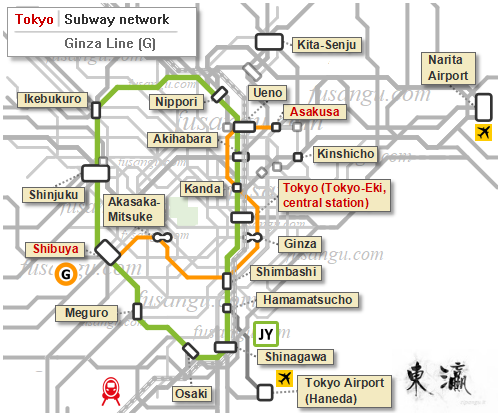
The Ginza-sen is a fundamental transportation tool for anyone who wishes to visit Tokyo, both for short and long stays.
The subway line connects some of the city’s most popular tourist areas and serves many important stations and transportation hubs.
In this page we describe a one-day tour along the Ginza Line. The article includes a programme suitable for short stays.
The Ginza Line is Tokyo’s oldest subway line. It is managed by Tokyo Metoro, the main operator. The line runs through the centre between two areas of major important such as Asakusa and Shibuya.
The Ginza Line connects the following areas:
-
Asakusa, historical quarter; Senso-Ji, a famous Buddhist temple, is located near the Asakusa Station;
-
Ueno, in the vicinity of Asakusa and Akihabara, around the station are important museums and one of Tokyo’s largest parks;
-
Ginza, noted as the cosmopolitan core of modern Tokyo and luxury hub. Aside from huge malls and glittering boutiques, here you can visit a few traditional and historical shops as well as temples and shrines;
-
Minato, a large upscale residential district, usually neglected by first-time visitors. Here are a few parks and green areas, some historical sites, museums, skyscraper clusters and few important temples and shrines;
-
Shibuya, a major entertainment area, synonym for fashion, latest trends, consumerism. Not too far from the main train stations are a few museums and places of cultural interest.
If you want to visit all these places we suggest you count on at least two full days, especially if you want to include a visit to Minato.
Below is the programme for a one-day tour through Asakusa, Ueno and Shibuya. All transfer can take place by solely using the Ginza Line.
Recommended itinerary along the Ginza Line
You can start your journey at Asakusa Station, the main transportation hub in Asakusa neighbourhood and a common access point for those who reach Tokyo from Narita Airport:
-
9:00 - 11:00: visit to Senso-Ji, historical Buddhist temples. Once you have gone through the Kaminari-Mon, an elegant gate, you enter Nakamise-dori, the large street leading to the main hall of Senso-Ji. Here are many tourist shops where you can find good-quality presents. Nearby is also Asakusa-Jinja, a Shinto shrine that miraculously survived the tragic 1945 fire bombings;
-
11:00 - 11:15: transfer along the Ginza Line between Asakusa Station and Ueno Station;
-
11:15 - 15:00: visit to Ueno. In around three hours and a half you pay a brief visit to the main museum of the area, the National Museum of Tokyo, and have a walk in Ueno Park;
-
15:00 - 15:30: transfer along the Ginza Line between Ueno Station and Shibuya Station;
-
15:30 - 18:00: visit to Shibuya. Just next to Hachiko Exit is the statue that commemorates Hachiko, the dog that in Japan became a symbol of loyalty and devotion. This is next to Shibuya Crossing, one of Tokyo’s most magnetic sightseeing spots, become a landmark that exemplifies the frenetic nature of the modern metropolis. All around are some of the city’s finest shopping malls. If you are more into cultural paths, do not miss out on a visit to the flagship store of Tsutaya, a renowned chain of bookshops. You can then have dinner in one of Shibuya’s izakaya, simple and often unassuming eateries. Shibuya is also a major entertainment hub that can cater to travellers from all walks of life.
Variants:
-
In spring: if you happen to visit Tokyo around the end of March you may want to add a short walk through Sumida Park. Located near the eastern shore of Sumida River, the park is noted for the copious presence of cherry trees, many of which belong to rare particularly ornamental varieties;
-
In autumn: there are no major autumn colour sightseeing spots near stations along the Ginza Line. Without getting to far, you may add a visit to the beautiful Koishikawa Koraku-En or Rikugi-En; both gardens are located in Bunkyo, a district located west of Ueno.
Related articles:
Main article: Tokyo 3-day itinerary
Itineraries along the subway lines (Asakusa, Hibiya, Ginza, Marunouchi, Tozai, Mita, Namboku, Yurakucho, Chiyoda, Shinjuku, Hanzomon, Oedo, Fukutoshin)
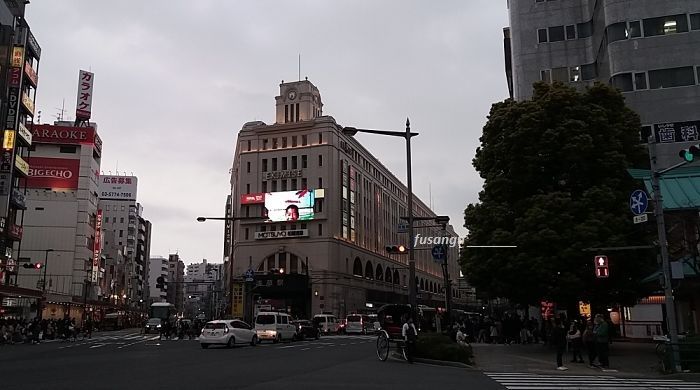
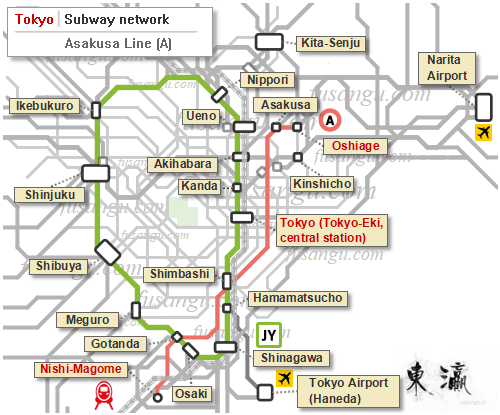
Among the vast network of subway lines that form the backbone of Tokyo’s mass transit system, the Asakusa Line plays a role of particular interest to those who visit the city for the purpose of tourism.
Furthermore, the Asakusa Line is used by through-service trains that link Haneda and Narita airports. Finding accommodation near one of the stations served by the Asakusa Line is certainly a strategic choice.
In this page we describe a one-day tour in eastern Tokyo. All transfers can happen by making exclusive use of the Asakusa Line.
The Asakusa Line (Asakusa-sen) is part of Tokyo subway network managed by Toei. The line crosses the eastern part of the centre of Tokyo along a north-south direction.
The termini are the following stations:
-
Oshiage, northern terminus; connection with the Hanzomon Line (Tokyo Metro’s subway network) and Keisei-Oshiage Line (part of the Keisei railway network). The station is served by trains that connect Narita Airport to Ueno and Asakusa;
-
Nishi-Magome, southern terminus, in Ota District.
The line serves areas of great interest to tourists such as the following:
-
Asakusa, historic neighbourhood situated north of Tokyo’s city centre;
-
Nihombashi and Ginza, in Chuo District, centre of Tokyo;
-
Takanawa, an upscale residential area in Minato District. Here are a few historic temples and museums.
From Nishimagome Station you can access Ota, the city’s southernmost district, where numerous parks, temples and onsen can be found.
Recommended itinerary along the Asakusa Line
An interesting itinerary can move from Oshiage Station, in Sumida District:
-
9:00 - 11:00: visit to Tokyo Sky Tree (Tokyo Sukai Tsuri), a large communication tower that offers unrivalled views over the metropolis and the wider region of Kanto. Nearby not to be missed out on is Japan Postal Museum;
-
11:15 - 13:45: visit to Asakusa. A short-walk from Asakusa Station and you can reach Senso-Ji, one of Tokyo’s most popular Buddhist temples. Along Nakamise-dori, the approaching path, are many tourist shops where you can find good-quality presents. In spring you may want to add a short walk through Sumida Park. Located near the eastern shore of Sumida River, the park is noted for the copious presence of cherry trees, many of which belong to rare varieties and whose flowering is most ornamental;
-
13:45 - 14:00: quick lunch;
-
14:30 - 17:00: visit to Takanawa, an affluent neighbourhood within Minato District. A must-see destination is Sengaku-Ji, ancient Buddhist temple, most famous for its connection to the vicissitudes of the forty-seven ronin. Not far are Hatakeyama Fine Arts Museum and Kakurin-Ji Temple.
Variants
Aside from including a visit to the centre of Tokyo (Marunouchi and Ginza), you can opt for additional destinations. Among the most interesting the following:
-
Ota: a large district located south of the city centre. South of Nishimagome Station is Ikegami Honmon-Ji, a large Buddhist temple. Nearby is a peaceful garden full of plum trees. Ota is very famous for the presence of onsen, thermal baths, many of which enjoy a solid reputation;
-
Meguro: the area around Gotanda Station offers a few temples and shrines as well as gardens. It can be included in a walking tour towards Nakameguro area, one of Tokyo’s best cherry blossom viewing spots.
Related articles:
Main article: Tokyo 3-day itinerary
Itineraries along the subway lines (Asakusa, Hibiya, Ginza, Marunouchi, Tozai, Mita, Namboku, Yurakucho, Chiyoda, Shinjuku, Hanzomon, Oedo, Fukutoshin)
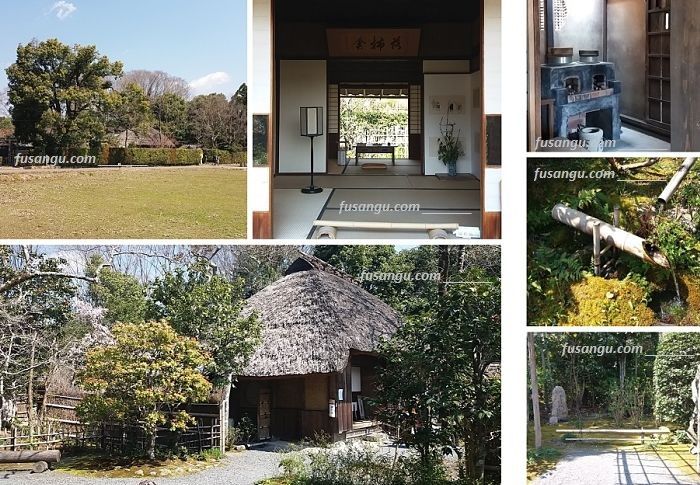
The JR Sagano Line is a railway line that provides a connection between Kyoto and the north-western part of the prefecture. The line is very useful for the purpose of tourism as it offers a cheap and fast way to reach important destinations such as the Nijo Castle and Arashiyama Scenica Area.
In this page we outline a few itineraries of different duration that require only movements along the JR Sagano Line.
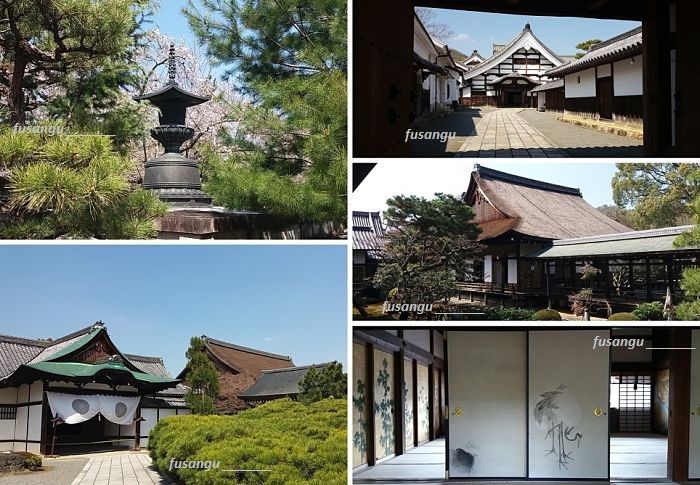
-
JR Sagano Line (essential information)
-
Main stations (of interest for visitors)
-
-
Itineraries along JR Sagano Line (1, 2 and 3-day programmes)
-
One-day tour (Arashiyama; Nijo Castle)
-
Two-day tour (Kyoto Railway Museum, Nijo Castle and Arashiyama)
-
Three-day tour (as with the 2-day tour, Kameoka and Myoshin-Ji)
-
JR Sagano Line
The section of the San’in Line that connects Kyoto and Sonobe is commonly referred to as Sagano Line (identified with the letter E on maps).
The line branches out from Kyoto Station (Kyoto-Eki) and runs through Shimogyo, Nakagyo and Ukyo districts before leaving the city’s urban area. Along the route are a number of stations that offer convenient access to some of Kyoto’s major sightseeing places.
JR Sagano Line main stations
Below is a list of station of particular interest to visitors:
-
Kyoto Station (E01): the city’s main station, connected to the country’s high-speed railway network and a few regional lines;
-
Umekoji-Kyotonishi Station (E02): near Kyoto Railway Museum and the municipal aquarium;
-
Nijo Station (E04): near Nijo Castle;
-
Hanazono Station (E06): near the large Buddhist religious compound of Myoshin-Ji;
-
Saga-Arashiyama (E08): gateway to Arashiyama, a mere 15-minute walk from the centre of Arashiyama;
-
Umahori (E10): near Torokko Kameoka Station of the Sagano Kanko Tetsudo Line, the so-called “romantic railway”;
-
Kameoka (E11): a small town most noted for a large park that draws large crowds during the cherry blossom season.
Scenic railway
A section of the original line was converted for tourist use (Sagano Kanko Tetsudo Line). The line follows the course of Hozu River, offering amazing views of the surrounding landscape.
Stations alone the line:
-
1) Torokko Saga (near Saga Arashiyama Station);
-
2) Torokko Arashiyama;
-
3) Torokko Hozukyo;
-
4) Torokko Kameoka (near Umahori Station).
Itineraries along the Sagano Line
Below are suggestions on how to organise an itinerary along the Sagano Line depending on the available time..
One-day tour
Having only one day you will have to renounce to a lot of interesting destinations. Depending on your interests you opt for different solutions.
Itinerary 1: Arashiyama
The first, most obvious solution, is to devote the whole day to Arashiyama, a scenic area full of cultural treasures.
We suggest you include the following places:
-
1) Togetsu-Kyo bridge;
-
2) A short walk along Hozu River;
-
3) Tenryu-Ji Temple;
-
4) Sagano Bamboo Grove;
-
5) Jojakko-Ji Temple;
-
6) Rakushisha ancient house;
-
7) Gio-Ji Temple;
-
8) Daikaku-Ji Temple.
You can reach all places on foot. Taxis rides offer the most comfortable alternative. Rides are cheap but if you want to save money you can get around by bus, at least between Daikaku-Ji Temple and the centre of Arashiyama.
Itinerary 2: Nijo Castle and Arashiyama
If you want to include a visit to Nijo Castle, you will have to reduce the number of destinations in Arashiyama.
A reasonable choice is as follows:
-
1) Nijo Castle;
-
2) Arashiyama:
-
Togetsu-Kyo Bridge;
-
Tenryu-Ji Temple;
-
Sagano Bamboo Grove;
-
Jojakko-Ji Temple;
-
Rakushisha;
-
Gio-Ji Temple.
-
Two-day tour
Spending a night in Arashiyama is a perfect choice if you wish to get out of the tourist bubble and live the atmosphere of a small locality. Doing so will allow you to enjoy pleasant walks in complete silence.
Arashiyama offers a number of hotels, many of which aim to cater for travellers that seek unique experiences. Many structures are traditional ryokans but there are also more modern-styled hotels and a few cheap and high-quality hostels.
Day 1
-
1) Kyoto Railway Museum;
-
2) Nijo Castle;
-
3) Arashiyama:
-
Tenryu-Ji Temple;
-
Sagano Bamboo Grove;
-
Kemayama Park;
-
Iwatayama Monkey Park;
-
Evening Walk along Hozu River.
-
Day 2
-
1) Sagano Bamboo Grove;
-
2) Jojakko-Ji Temple;
-
3) Rakushisha;
-
4) Gio-Ji Temple;
-
5) Saga Toriimoto Historic Street;
-
6) Adashino Nembutsu-Ji Temple;
-
7) Otagi Nembutsu-Ji Temple;
-
8) Daikaku-Ji Temple.
Three-day tour
If you choose to spend three days in Arashiyama there is plenty of opportunities to get out of the beaten tracks. You may want to visit Kameoka, reaching the little town with a ride along Sagano Scenic Railway (Sagano Kanko Tetsudo). Between Arashiyama and the centre of Kyoto you may add a stop to visit Myoshin-Ji, a large conglomerate of Buddhist temples.
In spring you should not miss out on a visit to Yawaragi-no-michi Park., which is near Nanatani River. You can reach it from Kameoka Station by bus or taxi.
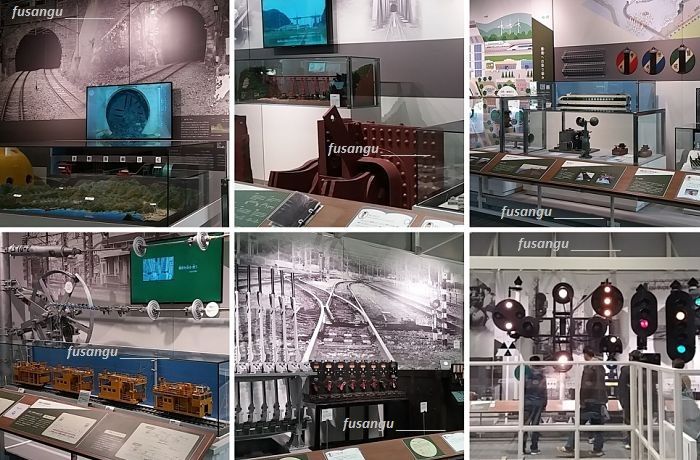
Related articles:
Main article: Kyoto 3-day itinerary
Itineraries along the Keihan Main Line: Southern Higashiyama | Northern Higashiyama and Sakyo
Page 4 of 8
